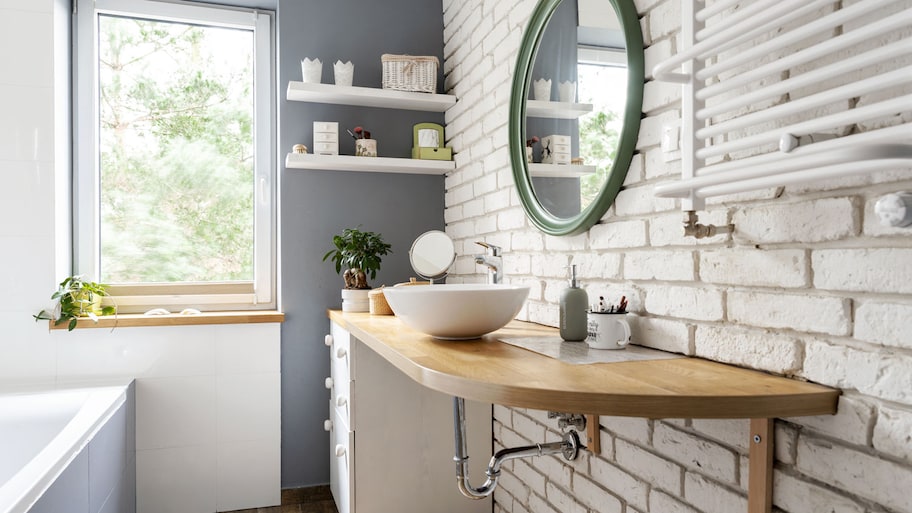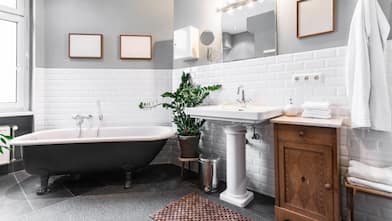Sleuth out where mold could be lurking in your house and keep your surfaces clean
Mold can be obvious or sneaky. You may notice a fuzzy spot on your wall or a suspicious speck by your bathtub. Perhaps you're experiencing an uptick in allergy-like symptoms. Whatever the case, if you suspect mold spores anywhere in your home, we've put together a checklist to help you look for signs of mold. If this is one project you'd rather not do, you can hire a mold inspector near you to do a thorough investigation.
1. Know What Mold Looks and Smells Like
Before you examine your home for mold, know the signs. Here are some common characteristics of mold:
Smell: A musty, earthy odor that can smell like old socks
Appearance: Often green, brown, gray, white, black, blue, or yellow. Can look like stains that are growing and make irregular spots on walls, furniture, floors, ceilings, ductwork, and grout
Texture: Feels like leather, cotton, sandpaper, or velvet
Location: May be near water damage, such as bubbling paint or water stains
2. Head to Your Basement
Your basement should be the first place you check for mold because it’s susceptible to moisture and humidity. Be sure to bring a flashlight to look in dark or narrow spaces. Here’s where mold is most likely to be found:
The corners of your basement
Near windows, vents, and window wells
Behind and around appliances like your washer and dryer
In or under the carpet
In or on the drywall
On or behind the baseboards
Near your water heater and furnace
On the coils of HVAC air handlers
Around your sump pump
Around pipes and ductwork
In your closets
Near the foundation where there might be leaks or water from the outdoors
Between furniture and the exterior walls
You can prevent future mold growth by reducing moisture in your basement. For example, run a dehumidifier if you suspect any excess moisture. You may also want to check for water seepage and damp or smelly carpet and walls after a heavy rain.
3. Look in Your Above-Ground Rooms

Mold and mildew can pop up wherever there’s moisture, so start by looking in rooms, such as your bathrooms, kitchen, and attic, or wherever you suspect a leak or water damage.
Check for mold in these common areas:
Bathrooms
Under and around the sink, especially near water pipes and valves
Around the bathtub or shower, especially in the grout and around caulking
Around the base of your toilet, behind it, and in the tank
On your shower curtain or door
Near the faucet and bathtub spout
In your toothbrush and toothpaste caddy
On the ceiling
On the bathroom rug and shower or tub mat
Kitchen
Behind your refrigerator in the fridge drip trays and water dispensers
In, under, and around the sink, including near valves and water pipes
In your refrigerator, including in food storage containers and drawers
In your pantry, including any open or expired foods
Around and in your microwave and stove
In and around your trash can and recycle bin
Attic
In your insulation
Near your intake and exhaust vents
On the roof, near possible leaks
The underside of your roof deck
Garage
Behind and under storage areas
Around the windows and doors
Near any areas with standing water
All Rooms
Under carpeting that got wet or feels damp
On drywall that may have gotten wet or feels soft
Behind peeling wallpaper
In ventilation ducts, near AC and heating vents
Ceiling corners, as they trap water from roof leaks
Around windows and window sills
Furniture, including couches and mattresses
Curtains and blinds
Indoor plants, especially if they’re over-watered
In your fireplace or chimney
In crawl spaces
In closets with limited ventilation
4. Test Your Walls for Mold
Mold can grow in and behind your walls, where it can be tough to see. But a distinct musty smell can give it away. Sniff the walls in areas that are prone to moisture, such as your basement and bathroom.
If you sense dampness or softness in your drywall, the mold might be eating away at the surface. You can test for mold by using a screwdriver to dig into the wall but avoid areas near wiring and outlets. If you smell or see mold in your walls, contact a mold remediation specialist.
5. Identify Indoor Leaks
If you spot mold near waste lines, water pipes, or plumbing fixtures, it might be because of a leak. Turn on the water and check the pipes and its surrounding areas for dripping water. If you find the leak, it can help prevent further mold growth and water damage.
6. Find Outdoor Leaks
If you see mold growing on your ceiling or an exterior wall, you may have a roof leak or other leak from outside, such as water seepage near your foundation. Make a note of where the mold is indoors by measuring the distance from the mold spot to the edge of the wall. Measure that same distance on the outside to identify where the leak might be happening.
Here are the key places to look for outside leaks:
Roof flashing
Vents
Decks
Window wells
Near rotting wood
The ground sloping near the house’s foundation
Downspouts
7. Inspect Your Ductwork
If mold is growing on your ceiling under a register or duct and you don’t see signs of a roof leak, your ductwork might be the culprit. When warm and cold air travels through the ducts, moisture can build up in drain pans and on cooling coils. Remove your vents and look for condensation in and around your ductwork with a flashlight.
If you detect mold, your ductwork might be poorly insulated or be missing a vapor barrier. Contact a local HVAC professional to see if they can take care of the issue for you.
8. Use a Mold Test Kit
You can find mold test kids online or at home improvement stores. Look for a test that detects mold spores in the air, not just on surfaces. Mold testing usually takes a few days, and you’ll need to send the materials to a lab to determine the type of mold.
Follow the instructions on your mold testing kit. General steps include:
Close the doors and windows of the room you’ll be testing
Collect the air sample in a petri dish
Limit traffic and airflow to the room while testing takes place (usually 48 hours)
Put the lid on the petri dish and tape it closed
Set the petri dish in a dark place
Check for mold growth
Test again if no mold is found
Send to the lab for mold analysis
9. Hire a Professional Mold Inspector
If you sense that you have mold in your house, but you don’t feel like you’ve found it all, it may be best to hire a professional mold inspector before remediation. They can catch spots you missed, identify the type of mold, and pinpoint the source of the problem. They can also help you remove mold and prevent mold outbreaks in the future—a professional mold inspection costs between $300 and $1,025.
10. Remove the Mold
If you discover a contained mold problem, such as a spot that’s smaller than 10 square feet like mold on the bathroom ceiling, you can usually take care of it yourself. Use bleach, vinegar, and hydrogen peroxide to remove the mold, but tea tree oil is the most effective natural mold killer. It's a bit more expensive than other options (about $10 for a 2-ounce bottle), but a little goes a long way. Mix 1 teaspoon of tea tree oil with 1 cup of water and spray the mold. The solution kills the mold and prevents it from returning.
Professional mold remediation usually costs between $1,120 and $3,334 or $10 to $25 per square foot. It’s best to call in a pro if you suspect large-scale mold or black mold.
11. Prevent Mold Growth in the Future
To keep your home mold-free and your air and surfaces clean, you can take these actions to prevent future mold growth:
Use a dehumidifier in your basement and other rooms with high humidity
Ensure your attic is well-ventilated
Check periodically for leaking faucets, pipes, and toilets
Inspect your roof once a year or after a severe weather event
Repair roof and plumbing leaks right away
Keep attic vents clear of insulation and clutter
Waterproof the exterior of your basement
Clean and remove debris from your gutters and downspouts
Ensure your home is properly insulated
Run your bathroom fan during and after taking a shower or bath
Leave your shower door open to let moisture escape
Ensure your bathtub, shower, and tiles are well-caulked
Clean surfaces regularly, especially counters, tubs, showers, floors, and tile
Wash your bath rug monthly
Dry moisture found near windows
Clear out old food from your fridge once a week
Clean the inside of your fridge a few times a year
Put waterproof protectors on your mattresses
Take out your trash at least once a week





